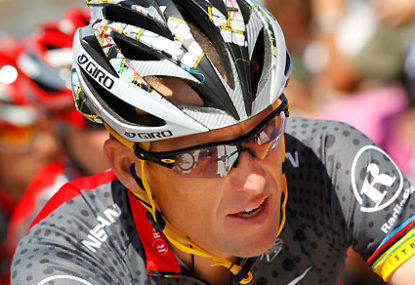'I've just won a stage of the Tour de France, mate!': Hindley grabs yellow jersey as Aussie blows Tour apart
Australia's Jai Hindley has said he is "lost for words" after a shock stage victory at the Tour de France earned him the leader's…

However it ends, USADA vs Lance Armstrong could hurt cycling. Once more, the sport’s dirty washing is spilling out of the basket – and it has to.
It makes and is going to make ugly reading, but do you know what? One day soon, sport as a whole will have a lot to thank cycling for.
Pro road racing has a long and well-publicised doping problem, but after years of prevarication and some wilful, misplaced and even cynical suspension of disbelief, cycling has the most stringent drugs testing programme in sport.
It’s only happened over the last five to seven years but it’s there now. It’s getting harder to cheat in cycling, but the same level and sophistication of testing hasn’t been adopted in all sports.
Look at London 2012, there was rigorous testing there and athletes and weightlifters got caught. Cycling didn’t score a single positive test. Other athletes were caught in the run up to the games as well.
Ok, I hear you say, but there’s all this anecdotal stuff about cheating the dope tests, and presumably we’re going to hear stuff from USADA about how it’s done, or at least was done.
Worse still, there are undetectable doping products and procedures out there, I wrote about some of them in a Roar piece earlier this year. Drugs tests taken now are being stored, but taking an undetectable is still a gamble some might take.
And some athletes will take drugs because they are hard wired to win. If not doping means turning their back on their potential, many will dope. They won’t want to, very few come into sport wanting to dope. They’ll be thoroughly decent people in every other facet of their life, but they will dope.
Are you depressed yet? Well don’t be.
The big thing for me that has changed in cycling in recent years is that top racers don’t need to dope anymore.
Many of the training, nutrition and legal manipulations that modern coaches and sports scientists prescribe mimic the effects of doping. And it’s easier to say no when you are already getting a legal high.
Take altitude training.
The concentration of natural EPO increases during the first 24 hours spent above 1500 metres and peaks at two weeks. EPO increases the production of red blood cells which take a further week or two to fully mature. These stay in the body for their natural life, so around 28 days.
A one month stay at altitude gives a responder (some people don’t respond to altitude) a six percent increase in red bloods cells for one month, which translates into a six percent boost in sea level performance.
It’s so potent that it would be dangerous to take synthetic EPO at the same time.
But some experts think that the blood boost is almost an aside to altitude. Living at altitude increases the number of blood capillaries in the lungs and muscles, so more oxygen gets picked up and delivered to a cyclist’s legs, and it’s an adaptation that stays. Even synthetic EPO, the most potent cycling drug, can’t do that.
Altitude also shifts the testosterone-cortisol balance in the body so it produces more testosterone, which is an anabolic or muscle building hormone, and reduces cortisol, a catabolic or muscle burning hormone. Cyclists have used artificial testosterone creams and patches to do that in the past.
Of course these adaptations don’t come free, altitude training has drawbacks and they have to be dealt with and factored into any training programme, but you can see why Bradley Wiggins and the Sky Pro Cycling Tour team spent so long on Mount Teide in Tenerife during their build up to this year’s Tour de France. And why Cadel Evans spends time in a hotel on top of the Stelvio Pass in Italy when he’s in Grand Tour training mode.
And there’s more. There are sea-level ways of training that boost hormone levels naturally, copying the effects of taking hormone-based drugs.
For example, increased growth hormone levels are experienced after 30 minute sessions at an athlete’s anaerobic threshold. And long but less intense endurance rides stimulate natural testosterone production.
Training in a way that achieves glycogen depletion promotes the production of an immune system product called IL6, which works like a wonder drug. It activates metabolic genes, promotes the breakdown of fats for fuel and inhibits insulin resistance.
Coaches really understand how a cyclist’s body reacts to different sessions now. They get feedback from power devices, heart rate monitors, heart analysis tools and blood and urine tests, so they know where their rider is at any time on the form and fitness curve.
Also there are sleep and nutrition manipulations that trick the body into producing an environment that promotes fitness, plus breakthroughs in nutrition have developed more bio-available sports foods.
I could go on, there’s enough of this stuff to fill a book.
For me though it’s important. If you look at the history of cycling it’s pretty unfeasible to think that one generation will suddenly turn its back en masse on doping, but if you give that generation the support to make doping unnecessary, then you can eradicate it.
Keep the faith, cycling is emerging from the doping tunnel and the future looks good.